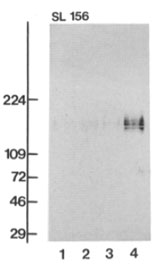Anti-Alpha Dystroglycan [VIA41] Antibody
This IgG1 mouse monoclonal antibody [VIA41] is reactive against alpha dystroglycan.
Highlights:
- Broad cross reactivity - Human, Mouse and Rabbit
- Suitable for Western Blot and Immunofluorescence applications
Dystroglycan is one of the dystrophin-associated glycoproteins that acts as a transmembrane link between the extracellular matrix and the cytoskeleton. They are involved in a number of processes such as lamnin and basement membrane assembly, sacrolemmal stability, cell survival, nerve myelination, nodal structure, cell migration and epithelial polarization. Specifically, alpha dystroglycan (an extraceullular glycoprotein) acts as a receptor for both extracellular matrix proteins containing laminin-G domains, and for certain adenoviruses.
From the laboratory of Kevin P. Campbell, PhD, University of Iowa.
 Part of The Investigator's Annexe program.
Part of The Investigator's Annexe program.
This IgG1 mouse monoclonal antibody [VIA41] is reactive against alpha dystroglycan.
Highlights:
- Broad cross reactivity - Human, Mouse and Rabbit
- Suitable for Western Blot and Immunofluorescence applications
Dystroglycan is one of the dystrophin-associated glycoproteins that acts as a transmembrane link between the extracellular matrix and the cytoskeleton. They are involved in a number of processes such as lamnin and basement membrane assembly, sacrolemmal stability, cell survival, nerve myelination, nodal structure, cell migration and epithelial polarization. Specifically, alpha dystroglycan (an extraceullular glycoprotein) acts as a receptor for both extracellular matrix proteins containing laminin-G domains, and for certain adenoviruses.
From the laboratory of Kevin P. Campbell, PhD, University of Iowa.
 Part of The Investigator's Annexe program.
Part of The Investigator's Annexe program.
| Product Type: | Antibody |
| Alternative Name(s): | Dystrophin-associated glycoprotein 1 |
| Antigen: | Alpha Dystroglycan |
| Accession ID: | Q14118 |
| Molecular Weight: | 156 kDa |
| Isotype: | IgG1 |
| Clonality: | Monoclonal |
| Clone Name: | VIA41 |
| Reactivity: | Human, mouse and rabbit |
| Immunogen: | Rabbit sarcolemma membranes |
| Species Immunized: | Mouse |
| Epitope: | Carbohydrate structure on alpha-DG |
| Buffer: | Cell culture supernatant |
| Tested Applications: | IF (1:20), WB (1:100) |
| Storage: | 4C short term, -80C long term (avoid freeze-thaw cycles) |
| Shipped: | Cold Packs |
Western blot of muscle membrane

Western blot showing monoclonal antibody VIA41 against SL156. Lanes 1-4 are KCL washed microsomes, light microsomes, pellet from the sucrose density step gradient and crude surface membranes from rabbit skeletal muscle. Molecular weight markers on the left.
Adapted from: Ohlendieck, K. et al., J. Cell Biol. 112 :135-148, 1991.- Ervasti JM, Ohlendieck K, Kahl SD, Gaver MG, and Campbell KP. Deficiency of a Glycoprotein Component of the Dystrophin Complex in Dystrophic Muscle. Nature 345, 315-319, 1990
- Ohlendieck K and Campbell KP Dystrophin-Associated Proteins are Greatly Reduced in Skeletal Muscle from mdx Mice. J. Cell Biol. 115, 1685-1694, 1991
- Ohlendieck K, Ervasti JM, Snook JB, and Campbell KP. Dystrophin-glycoprotein complex is highly enriched in isolated skeletal muscle sarcolemma . J. Cell Biol. 112 :135-148, 1991.
- Durbeej, M, Larsson, E, Ibraghimov-Beskrovnaya O, Roberds SL, Campbell KP, and Ekblom P. Non-Muscle alpha-Dystroglycan Is Involved In Epithelial Development. J. Cell Biol. 130, 79-91, 1995.
If you publish research with this product, please let us know so we can cite your paper.

![Anti-Alpha Dystroglycan [VIA41] Antibody Anti-Alpha Dystroglycan [VIA41] Antibody](https://www.kerafast.com/MediaStorage/Product/Images/Medium/868_200120200126258670.jpg)
